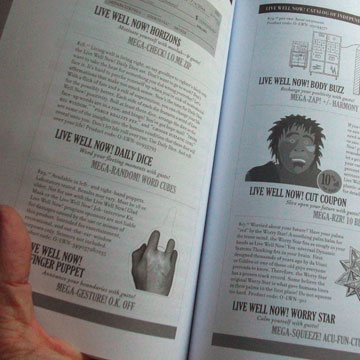JULY 31, 2009
There's nothing funny about design

Indeed. It's a shame that designer/design critic David Barringer didn't take the title of his own book
more seriously.
This collection of essays works best when it's discussing how design relates to everyday life. It gets tedious when he stretches an ironic comment into an entire section, as he does with Success Your Future and The Business of Design.
For fifteen pages Success Your Future riffs on the self-help craze, showing products like the Worry Star, Daily Dice, and an Official Self-Acceptance Certificate.
As satire goes this is far from original, but worse yet, it's 1) not funny and 2) not specific to design/designers. For example:
Got a small P.P.? Why your P.P. so tiny? That's P.P., short for Profit Production. With a small P.P. you can't give your customers what they really need. They need it bigger, better, faster, and cheaper. But you have a teeny P.P. and you can't keep it up. (pg. 173)
C'mon now. This could just as easily be in MAD magazine or The Onion. Except they'd make it funny.
Why did you buy the book?
Good question. I saw it mentioned online and was swayed by an editorial review "...Barringer is both an insider and outsider to the design discourse. He makes sense of what designers do and then takes us apart with his needle-sharp verbal tools," or the lone customer review (5 stars!) at Amazon.com
"...Barringer's talent lies in taking apart the everyday, and making the reader keenly aware of why it matters. Or how it fails..."
Since my design training—undergrad, graduate and on-the-job—emphasized design as craft, I'm always looking for insights into the theory and principles of design. I know I need to understand the why of design, not just the how. I thought this book might help, and at first I was encouraged. I even read it with a yellow highlighter at my side, marking passages like "But designers must be conscious of the act of seeing, of the limits of vision, and of frames—frames of perspective and frames of presentation" (pg. 11).
Early chapters were promising. Paradise explores how pharmaceutical companies name their newest drugs. Carnage for Kids shares a designer/dad's concerns about gory DVD covers at the video store. Designer Snakes makes you wonder about the ethics of collecting snakes bred exclusively to be colorful. I thought Left Wanting, a plea for liberal magazines to abandon their usual conservative design, was both right on target and long-overdue.
It's when Barringer tries to be clever, as in Myth of the Self-Taught Designer (which he describes as a "...hybrid mess of a literary shenanigan..." and Warning! A New You Ahead (mentioned above) that the book became painful. I skipped through The Business of Design, never quite sure if it was tongue-in-cheek or serious advice. When I got to How to Interview for a Job I'd lost interest in trying to figure out the difference.
Top |
|
![]()
